How to Prevent Resize Slide From Erasing Formatting (part 3)
The solution we use at TLC Creative Services is to remove the variant. The simple answer is to save the presentation as a PowerPoint template (.potx) which creates a file with no variants. Here is a quick step-by-step process:
1. Go to File>> Save As >> POTX from drop down list
- Save to the desktop (this is a temporary file you will delete)
- Use a file name that is applicable to the template
- Note 1: The file name will be seen in the file properties
- Note 2: A .potx is a PowerPoint template and it cannot contain slides, so doing this is going to DELETE all slides (which will be added back in a few steps)
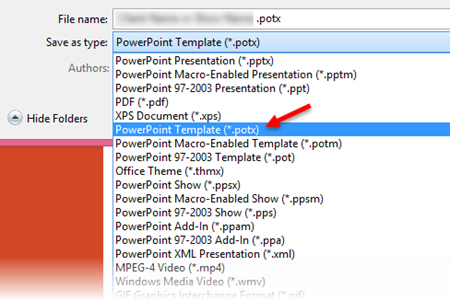
2. Open the new .potx file and look at the file properties
- Creating a .POTX removes the Default Theme ID
- The TEMPLATE property will now list the .POTX file name
- Note: When you open a .potx, it automatically creates a .pptx presentation file.
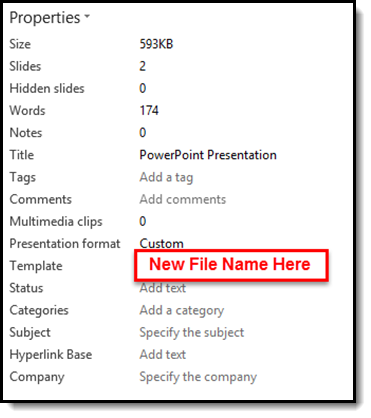
3. Go to FILE > SAVE AS > POWERPOINT PRESENTATION (.pptx) from the drop down list
- Opening a .potx automatically creates a .pptx presentation file
- Open file is most likely named “Presentation1.pptx”
- Save presentation with a new file name – Best Practice: Name same as original file name + version # (eg. _v2)
4. Go to DESIGN tab > VARIANTS section
- The presentation now has no VARIANTS
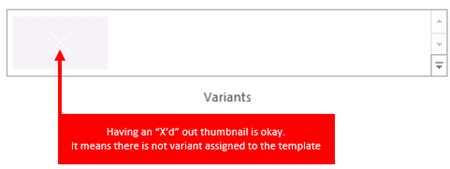
7. Add slides from original presentation to the new, no variant, presentation and save file
8. Delete the temporary .potx and the original presentation
9. Use the Resize option without losing template formatting!
– Troy @ TLC
Why Resize Slide Erases All Formatting (part 2)
The previous post showed how template formatting is often stripped out of a presentation when it is resized.
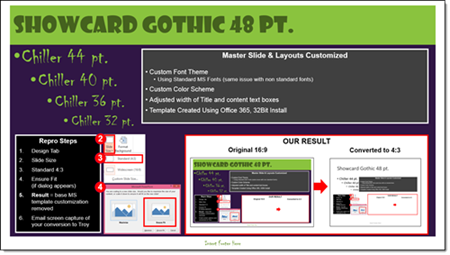
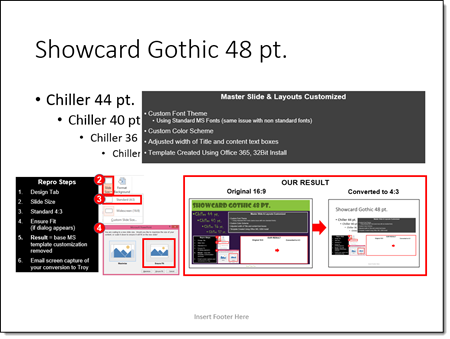
So here is my simple, non-tech description of what is happening inside PowerPoint (Note: If you really want details on templates and themes, I highly recommend Echo Swinford and Julie Terberg’s excellent book: Building PowerPoint Templates Step by Step with the Experts).
The resize “bug by design” will only happen with presentations and templates developed in PowerPoint 2013 and above. Files created in PPT 2007 and 2010, even if edited in 2013, do not have the resize issue because those versions of PowerPoint do not have the troublemaking feature. With PowerPoint 2013, a new option for templates was added, VARIANTS. Variants will eventually be a great feature, but currently they are not really used and the “Super Theme Templates” they open the door to create are so difficult to develop, I only know a few designers in the world who really understand them and are willing to tackle them (and I am not one of them).
Variants, which you see in the Ribbon on the Design Tab, are basically template styling options.

When resizing slides, PowerPoint needs to use a variant. If there is not a custom variant already there from a Theme, PowerPoint reapplies the Microsoft Default Theme. The default theme, called “Office Theme,” is what you get when opening a new blank presentation (boring, white, no stylized formatting).

When the default theme, and its variants, are applied, all formatting to the master slide and layouts are replaced with this “default” setup. What this means is nicely designed slides lose their existing template styling attributes. See the previous post for a downloadable sample slide you can test and see formatting stripped.
Here are 2 ways I do a quick check to see if a provided file is going to have an issue if it needs to be resized:
1. Go to FILE > PROPERTIES > expand to see all properties > TEMPLATE
– If the TEMPLATE property is BLANK or has “OFFICE THEME,” I know it is almost 100% certain to have formatting issues if resized
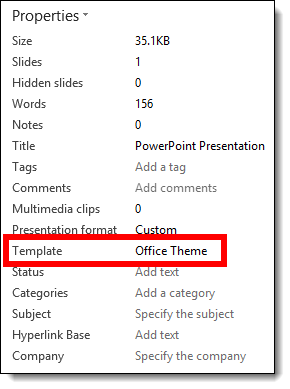
2. Or I look at the DESGIN tab >> VARIANTS section and see what variants are available (Note: If there are no variant thumbnails, that is covered in part 3, and it is okay)

The next post, part 3, is a step-by-step solution to avoid PowerPoint adversely affecting slides when resized.
– Troy @ TLC
Resize Slide Erases All Formatting! (part 1)
Here is the scenario: you have a 16×9 presentation that needs to be changed to 4×3. Easy! PowerPoint has a great feature to change the aspect ratio (via Page Setup) and it keeps everything proportional (eg. circles stay round) and adjusts the position of everything to fit the new slide layout – but things don’t go as smoothly as planned.
1. Here is your 16×9 slide (download this PowerPoint 2013 Resize Test Slide):

2. Go to DESIGN > SLIDE SIZE > STANDARD 4×3
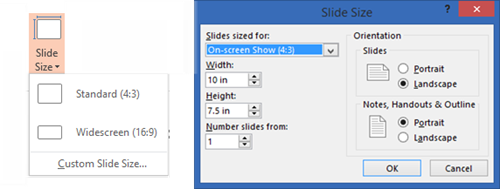
3. Here is the disaster you get when converting to 4×3

Note: This problem is not the size selected (4×3), it happens when going from any size to another size. And this is not a bug, but by design (I really like how Echo Swinford describes this as “a bug by design”). What you end up with is:
– Correct page size – yay!
– Custom background – gone
– Custom fonts – gone
– Custom color scheme – gone
– Any template customization – gone
Part 2 and 3 of this series detail what is happening behind the scenes in PowerPoint and a (fairly) simple step-by-step solution.
– Troy @ TLC
Permanently Delete a File with Eraser
Here at TLC, our team works hand in hand with companies dealing with all sorts of information. One week, you may find us setting up show computers for a large event for a pharma company, and the next week, onsite running presentations for an executive of an auto corporation. Our computers are always operated by internal staff, but it is imperative to secure information.

Dropping files into the Recycle Bin is not really deleting them – it is only the operating system removing the reference of the files from the system table. Every file is really there until another file is saved over it. Eraser permanently overwrites files with patterns of data that completely prevents file recovery. So, whether you want to securely erase financial records, passwords and/or security data, Eraser is a free, easy to use program that makes files gone for good. Eraser can be found here (go to the download link at top of page – do not use any of the adware download buttons!).

– Troy @ TLC
Oh the many ways to advance a slide
Everyone knows a few ways to advance to the next slide. Everyone seems to use different options (none are wrong). Here is a quick list of the 7 most common slide advance options.







– Troy @ TLC
Introducing Office UserVoice!

Microsoft is (finally) taking the input of its user more seriously, and not just their large enterprise customers (where the lead IS contact was the input person) and the MVP teams. This is for their entire user base! Microsoft has partnered with an external company to “engage with customers about new features and ideas.” UserVoice is something I am very excited about.

- Covers all platforms: Windows (Desktop & Mobile), Mac, iOS, Android, and the Web
- Separate pages for each Office app: PowerPoint, Excel, Word, Outlook, OneNote, Sway
- Goal is to gather end user input (that’s you and me!) on features we see as needed in an Office app. Microsoft, from what I have been told, is going to have this data be a factor in determining what they need to focus on.
- Vote for the ideas you like. This is a big part of the data that Microsoft will be receiving – “how many people agree with this being a needed feature?” NOTE: Each user only gets 10 votes!
- UserVoice is not a forum for tech support. Its purpose is hearing what people want to see. This is great for me to see as Microsoft continues to move toward a constant app evolution and roll out of new and improved features vs. new version every 2+ years.
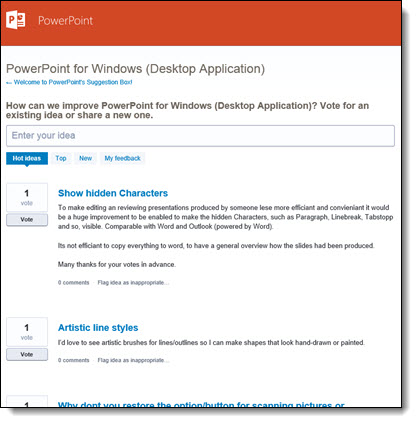
Bookmark and make entries when you have a great idea (or major frustration in the middle of project about what would make life better!). Here are links to each app:
[br]
– Troy @ TLC
What Computer Should I Get – My opinion on specs
[text]All the way in 2006, I posted about computer specs and my recommendations (read it here). 9 years later, those specs are comical by today’s standards. Of the 20+ computers here, not one is in line with those dated specifications – none are that wimpy.[/text]

[text]Here is an updated list of specs I look for in new design computers. Note: This is all about Windows computers, Macs are a separate conversation. One thing remains the same since 2006, “Get the biggest, fastest, and most powerful.”[/text]
[text]I need to also highlight that the computer specs are only 1 part of the solution, and they are the easy part. The other part of having a full graphics computer is setup and software. We invest hours into setting up every computer and even more time into the almost continuous process of configuring new updates, drivers, software and settings.[/text]
- Intel i7 CPU or 2.2 GHz (i5 is perfect, but the i7 configurations generally include everything else on the list, where the i5 is often the budget configuration and lacks other needed specs)
- 16-32 GB of RAM
- 1-4 GB of Video RAM (There is a vast in performance between in shared vs. dedicated memory GPUs. Dedicated memory and separate processing are mandatory, which is NVidia or ATI GPUs)
- 1920×1080 local monitor resolution (minimum)
- USB 3.0 (+ data thunderbolt is a great option)
- DVI or mini-display port (Thunderbolt) are my preference. HDMI is lower on my preferences; but that is due to interfacing with showsite equipment, which most will not have to worry about
- 1 GB Ethernet port (adaptors are not what you want to deal with on a work station setup
- SSD hard drive
[text]Will this be my recommendations next year, or in 5 years? Doubtful. I am already holding off purchasing additional computers while waiting for USB-C, wider (Windows) adoption of Thunderbolt data, new generation of CPUs and more.[/text]
[br]
– Troy @ TLC
